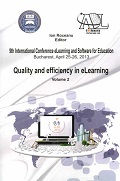APLLYING REAL-TIME SIMULATIONS TOWARDS TEACHING PHYSICS
APLLYING REAL-TIME SIMULATIONS TOWARDS TEACHING PHYSICS
Author(s): Florin Mingireanu, Fabian BreharuSubject(s): Education
Published by: Carol I National Defence University Publishing House
Keywords: simulation; Runge-Kutta; numerical; Physics; models; elearning
Summary/Abstract: Nowadays, mathematics, sciences and physics in particular offers students a wide range of career opportunities and alternatives. Attracting students to mathematics and physics proves to be a more difficult job than in the past due to shrinking educational budgets as well as a wider range of career and job opportunities for non-science jobs (e.g.: lawyers, humanities, arts etc.). At the same time, we show that simulation based modules are one of the best ways to use the computers in teaching physics and showing natural phenomena otherwise difficult or, even, impossible to show in classroom with conventional methods. Simulations range from the celestial motions that sometimes take billions of years to complete to atomic level phenomena which are again difficult to observe due to their very small size and very fast speeds. We show a Runge-Kutta 4 based simulation toolset that can be used to integrate a wide array of differential equations that are at the basis physics phenomena like the ones mentioned above.Several physics simulation examples are shown together with the context in which they can be used along with a series of future capabilities/add-ons that can transform this material into self-learning material as well. We show the difference between the self-learn material and the teaching based on classroom material as well as how simulations can provide a bridge between these two sets.
Journal: Conference proceedings of »eLearning and Software for Education« (eLSE)
- Issue Year: 9/2013
- Issue No: 02
- Page Range: 586-591
- Page Count: 6
- Language: English

